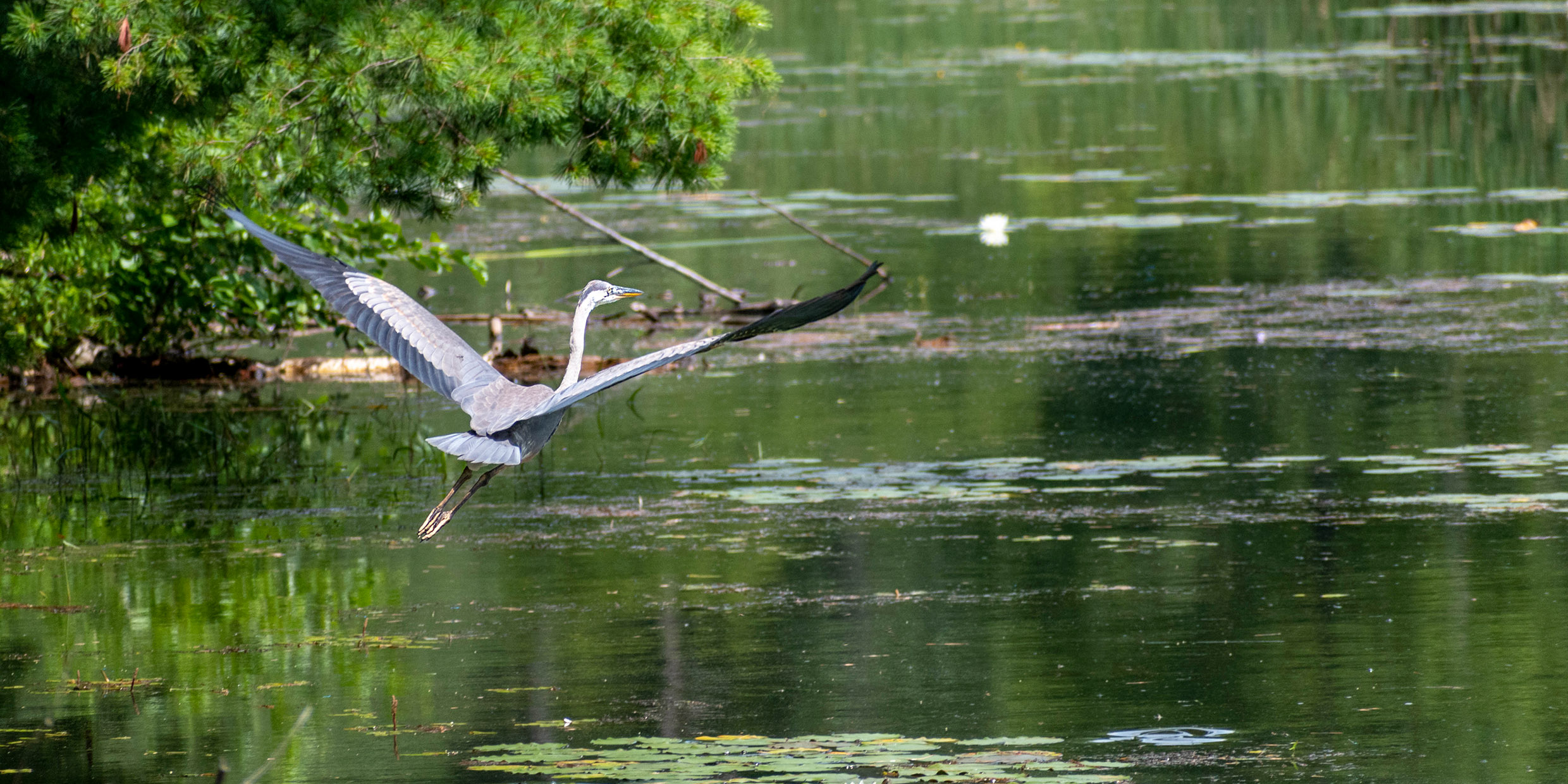Originally published 10 May 1999
If you have ever watched a jumbo jet take off you will know what I mean.
The thing seems too massive and moving too slowly to remain suspended on the air. It appears to be borne aloft by invisible cables, or drawn skywards by spell or incantation. It simply does not seem possible that the tenuous buoyancy of air could lift those bulky tons.
And so it is watching a great blue heron rise from the marsh. Startled, it heaves itself into flight, the great wings billowing like bedsheets in a breeze, the neck arching — pull, pull — the kite-string legs dangling behind. It’s too big. It’s not possible. But nevertheless it rises — majestically heavenward.
No other New England bird cleaves the air with such grandeur. Not even the eagle or great horned owl conveys such grace, in both meanings of the word: seemingly effortless beauty or charm of movement, form or proportion; a gift bestowed by one who need not do so. The heron rises in magnificence and magnanimity.
How does it do it? What is the power of this bird to touch our minds and hearts ?
The naturalist Aldo Leopold was intimately familiar with the cranes of Wisconsin, cousins of our great blue herons, and wondered often about their ability to move us deeply. In A Sand County Almanac he watches as a crane “springs his ungainly hulk into the air and flails the morning sun with mighty wings.” Our ability to perceive beauty in nature, as in art, begins with the pretty, he says, then moves into qualities of the beautiful yet uncaptured by language. The beauty of the crane lies in this higher realm, he proposes, “beyond the reach of words.”
Words may fail, but nevertheless poets have tried to capture the ineffable.
John Ciardi sees “a leap, a thrust, a long stroke through the cumulus of trees” and stops to praise “that bright original burst that lights the heron on his two soft kissing kites.”
Theodore Roethke observes a heron aim his heavy bill above the wood: “The wide wings flap but once to lift him up. A single ripple starts from where he stood.”
Even Aldo Leopold does not forego language, and chronicles the crane’s history in deft words. Not only its local, present history, but also the deep history of the bird’s tribe, reaching back into remote geological ages. When we hear the crane’s call, he says, we hear no mere bird: “We hear the trumpet in the orchestra of evolution. He is the symbol of our untamable past, of that incredible sweep of millennia which underlies and conditions the daily affairs of birds and men.”
I suspect that Leopold is right, that our response to the rising heron is at least partly conditioned by our long entanglement with birds, a racial memory of bright wings and dark shadows. We watch and we long for the gift of flight — expedient escape, unimpeded travel.
Sometime back in the Jurassic two evolutionary paths diverged — birds and mammals from vertebrate ancestors. Our earliest mammalian parents took to the ground, digging deep, dark burrows to escape reptilian predators. The birds sprang into the air on kites of feathers. We look today at those “ah! bright wings” and wonder at the road not taken.
In Chekhov’s The Three Sisters, sister Masha refuses “to live and not know why the cranes fly, why children are born, why the stars are in the sky. Either you know and you’re alive or its all nonsense, all dust in the wind.”
Why? Why? Instead of putting computers in our elementary school classrooms we should take the children out into nature, away from those virtual worlds in which they spend unconscionable hours, and let them see a heron rise from the marsh, hear the guttural call, feel the lightning thrust of the beak. Let them stand near a morning marsh and shiver in the thrall of cold and beauty.
Then in the classroom let them inspect a reproduction of Audubon’s great blue heron, bluer than any heron you will see in a marsh, with its rapier beak and golden eye and waterfall of feathers. Let them examine feathers and bird bones under a good dissecting microscope (cheaper than a computer). Show them a photograph of plumed Archaeopteryx, asleep in its bed of 150 million year-old limestone. Read them Ciardi’s poem Two Egrets—“like two white hands/ washing one another/ in the prime of light” — and let them try their own hand at expressing the inexpressible in words.
“Either you know and you’re alive or it’s all nonsense, all dust in the wind,” says Masha. Let the children know. Let them know that nothing, nothing they will find in the virtual worlds of Game Boy or the Internet matters half so much as the step into the air of a great blue heron, rising into morning mists on Gabriel wings, conferring on the marsh, the morning, the watcher, a dignity, a blessedness that confounds the dull humdrum of the commonplace and opens a window to infinity.



